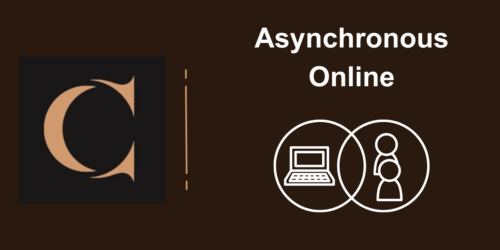7 Steps to Being “Present” as an Asynchronous Online Teacher
It’s the teacher that makes the difference, not the classroom.
(Morpurgo, 2012)
Even when you perform no live teaching, as an asynchronous online professor you still play a critical (and creative!) role in supporting and guiding student learning experiences in an asynchronous course.
Teaching presence is a foundational aspect of your role in asynchronous course delivery. According to pioneer researchers in eLearning, teaching presence is the facilitation and direction of cognitive and social processes in the asynchronous classroom to guide and support learners to achieve meaningful and educationally worthwhile learning outcomes (Anderson, Rourke, Garrison, & Archer, 2001).
An Overview of Ways to Be Present
First, watch this short video for an overview of ways to show “teaching presence” in the asynchronous online classroom. As you watch: What is one strategy you might want to focus on in your delivery?
Next see these 7 steps for building and maintaining your teaching presence across the semester.
Step 1: Know your eConestoga course
Get to know your course, noticing anything that needs to be updated or fixed before the course shell goes live to students. Get to know your course shell by ensuring
- the “Professor/Facilitator Guide” is reviewed,
- the Instructional Plan is visible,
- the grades breakdown matches the Course Outline,
- assessments due dates match the calendar, and
- information on accessing digital texts or other “required resources” is available.
Step 2: Share about you
Consider adding some details about who you are as a professor (and a human) and how students can reach you. You can include
- Professional expertise (a summary, links to professional associations, projects you’ve completed)
- Appropriate personal details, fun facts, photos (background, family, hobbies)
- Conestoga College contact information and response time (48 hours as per the Conestoga HR Policy). Remind students to use their eConestoga email address.
Avoid simply copying from your resume; select what is most relevant and interesting to students!
Step 3: Create a brief video orientation
Add and embed a video into your first-course announcement or in the “Course Information” section so that students can get an overall sense of what is in the course and what they must do to succeed.
- What should students expect to do in this course
- Why the course topics matter for the program or industry
- What course and program rules apply (e.g., Program Handbook)
- Where students can find what they need to do next
Create a “breadcrumb trail” using a numbered list or checklist to follow easily.
Step 4: Build community with a class icebreaker
If you already have an icebreaker embedded into your discussion board, that’s great! Here are some ways you can get buy-in for this initial class activity.
- Explain your purpose
- Model a response
- Be enthusiastic
- Remind about conduct expectations (e.g., class-appropriate responses, culturally sensitivity, no personal identification information)
Note that you can do icebreakers/energizers throughout the semester!
5. Keep students regularly engaged
There are plenty of ways to continue to engage students by providing announcements emails that contain helpful, just-in-time information. Here are some ideas for some small, bite-sized ways to support your students’ interest, persistence, and course success.
- Current events
- D2L “how to” videos links
- Online study tips
- Encouragement messages
- Academic Dates and Religious Holidays
- Due date reminders and checklists
- Updates about course issues
- A check-in survey (e.g., Start, Stop, Continue)
- Optional drop-in or assignment information Zoom meetings
It is important to reach out multiple times to students who appear disengaged. Regularly check students’ course and grades process (using the eConestoga dashboard tools), and reach out by email.
6. Give constructive, timely feedback
There are many opportunities to give formative and summative feedback to your students over the term. Especially because there are no live meetings, giving a range of feedback is especially helpful to maintain your “presence” in the asynchronous classroom.
Individual
- Written, visual, video, or audio feedback on graded assignments
- Course and Grades progress updates
- Drop-in /one-on-one meetings
Group/class
- End-of-week discussion summary
- Video with advice for assignments
- Explanations of tough questions
- Batch emails to students who have not yet submitted assignments
- Group check-in meetings
7. End the course with what comes next
It’s never too soon to be thinking about how to craft an end-of-course message. Here are some ideas of what you might want to include.
- Celebration/congratulations
- Reflect on course learning goals
- Provide end-of-term information (assignment reminders, grades, appeals, etc.)
- Reassure students who fail: options available and who to contact
Resources
- Faculty Learning Hub: Anytime support for asynchronous teaching and learning
- EConestoga Youtube video playlist: Self-directed videos for faculty
- eConestoga email and daily Zoom drop in for eConestoga technical support
- IT Help Desk email for employee technology support
- Teaching and Learning email for consults and advice
- Program Handbooks: Requirements and guidelines for the program and student progression
- Conestoga Policies and Procedures
References
Garrison, D. R., Anderson, T., & Archer, W. (2000). Critical inquiry in a text-based environment: Computer conferencing in higher education model. The Internet and Higher Education, 2(2-3), 87-105.
Morpurgo, M. (September 14, 2012). “The class system: Michael Morpurgo’s schooldays.” www.theguardian.com.
Quality by Design. (2016). Creating Instructor Presence. [Video.]



